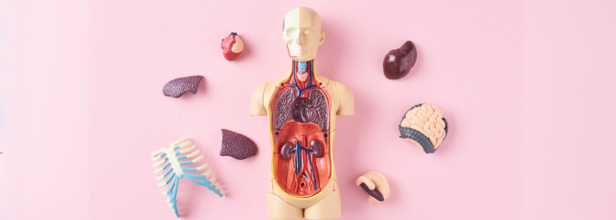- Health Conditions A-Z
- Health & Wellness
- Nutrition
- Fitness
- Health News
- Ayurveda
- Videos
- Medicine A-Z
- Parenting
How Old Are Your Organs? New Study Links Organ Aging to Disease Risk

Credits: Canva
A new study published in The Lancet Digital Health suggests that biological age of different organs could predict a person's risk of diseases such as cancer, dementia, and heart disease than their actual chronological age. The research analyzed long-term data from Whitehall II study, which had been followed by over 10,000 British adults for more than 35 years.
The blood plasma samples were collected between 1997 and 1999 from participants between ages 45 to 69. Researchers have now examined a follow up data from 6,235 participants, who were by then aged 65 to 89. This was done to see how aging of specific organ may correlate with the development of diseases over two decades.
What Organs Were Studied?
The study measured the biological age of nine key organs, including:
- Heart
- Blood vessels
- Liver
- Immune system
- Pancreas
- Kidneys
- Lungs
- Intestines
- Brain
The researchers were able to find that different organs aged at different rates in different people. In many of the cases multiple organs showed signs of faster aging within the same individual. What is important to note is that those with accelerated aging in certain organs had a higher risk of developing 30 out of the 40 age-related diseases the study had tracked.
Organ Aging And Disease Risk
Some organ-disease connections were expected—people with rapidly aging lungs were more likely to develop respiratory diseases, and those with aging kidneys had an increased risk of kidney-related conditions. However, the study also found less obvious associations.
For example, individuals with fast-aging kidneys were more prone to diseases in other organs, such as the liver and pancreas. Additionally, multiple fast-aging organs were linked to an increased risk of kidney disease.
One of the most surprising findings was that dementia risk was not best predicted by an aging brain but rather by the immune system’s biological age. This suggests that factors such as chronic inflammation and immune health may play a critical role in neurodegenerative diseases.
What Is Organ Specific Blood Tests?
The study also highlights the important of the potential of developing blood tests that could assess the biological age of specific organs. Unlike previous complex methods that measured the organ health, this new approach could make things simple to detect early signs of disease.
The leader author of the study Mika Kivimaki, who is also a professor at the University College London's Faculty of Brain sciences pointed out that such tests could be helpful when it comes to guiding personalized healthcare. In a news release, Kivimaki said, "They could advise whether a person needs to take better care of a particular organ and potentially provide an early warning signal that they may be at risk of a particular disease."
The study reinforces the idea that aging does not affect all organs equally and that looking beyond chronological age could offer better insights into disease prevention. By understanding which organs are aging more rapidly, medical professionals may be able to recommend targeted interventions for individuals at higher risk of specific conditions. Future advancements in organ-specific blood testing could revolutionize how we detect and manage age-related diseases, potentially leading to more personalized healthcare strategies.
Weight Loss Jabs: What Happens To Your Body When You Stop Taking Them?

Credits: Canva
Weight-loss jabs, or GLP-1 receptor agonists, have provided many people with results that diets alone could not achieve. For those struggling with constant cravings, these medications have quieted the persistent “food noise” that often drives overeating. They have transformed not only body shapes but also self-confidence and daily habits.
Yet questions remain: can people safely stop taking these drugs, and what happens to the body when they do? These are still largely unknown, as the drugs are relatively new. GLP-1s mimic a natural hormone that controls hunger, but the long-term effects are only beginning to be understood. Additionally, for the estimated 1.5 million people in the UK paying privately for these injections, maintaining treatment can be costly.
Two women, Tanya and Ellen, share their personal experiences with the BBC on weight-loss jabs and what life was like when they attempted to stop.
Weight Loss Jabs: Tanya Hall’s Experience
Tanya, a sales manager in the fitness industry, initially started taking Wegovy to challenge her own perceptions about weight and authority. She often felt overlooked or undervalued because of her size, and hoped that losing weight would change how others treated her, as per BBC.
Early in treatment, Tanya experienced side effects including nausea, headaches, sleep issues, and hair loss, which she describes as clumps coming out. Despite this, she steadily lost weight—six stone (38 kg) over 18 months—and the injections quieted the relentless urge to eat.
However, every time she tried to stop, her appetite surged within days, leaving her horrified at her own eating. Now, Tanya continues the medication, feeling it has become essential to maintaining her weight and the confidence it brings.
Weight Loss Jabs: What Happens To Your Body When You Stop Taking Them?
Wegovy’s manufacturer, Novo Nordisk, stresses that treatment decisions should be made with medical guidance and that side effects must be considered. Lifestyle GP Dr. Hussain Al-Zubaidi likens stopping GLP-1s abruptly to being hit by a “tsunami” of hunger.
Research shows that within one to three years of stopping these medications, people can regain 60–80% of the weight they lost. This highlights how these drugs work not just by reducing appetite temporarily but by fundamentally altering hunger cues.
Weight Loss Jabs: Ellen Ogley’s Journey
Ellen turned to Mounjaro after reaching a critical point in her life. Her weight had put her at risk during surgery, and emotional binge eating dominated her daily habits. Once on the medication, Ellen noticed her compulsive eating completely stopped.
Over 16 weeks, she lost 3 st 7 lb (22 kg) and began tapering off the injections over six weeks. She focused on developing a healthier relationship with food, creating balanced meals, and incorporating exercise into her routine. Despite some weight creep after stopping, she has since lost a total of 51 kg and now feels confident her habits are sustainable.
Weight Loss Jabs: The Importance of Support
Dr. Al-Zubaidi emphasizes that exiting GLP-1 treatment safely requires guidance and long-term support. NICE recommends at least a year of tailored advice after stopping injections to help individuals maintain their weight and prevent relapse, as per BBC.
For patients paying privately, such structured support may not always be available, increasing the risk of regaining weight. Lifestyle, mindset, and environmental factors play a significant role in long-term outcomes.
Tanya has chosen to continue with her medication, aware of the pros and cons, while Ellen has closed that chapter and built a sustainable routine for life after Mounjaro.
Weight-loss jabs can dramatically change appetite and body weight, but stopping them can be challenging. The transition off these drugs requires careful planning, support, and lifestyle adjustments. As Tanya and Ellen’s experiences show, the journey varies by individual, and long-term strategies are essential to maintaining health and weight loss results.
Eli Lilly, the manufacturer of Mounjaro, states that patient safety is its top priority and that it continually monitors and reports information on treatment outcomes to regulators and prescribers.
Flu Cases Surge Across The US: How Long Does The Super Flu Remain Contagious?

Credits: Canva
Flu Symptoms: Seasonal infections are spreading across the United States just as the holiday travel rush gets underway, worrying health officials about fresh spikes during family get-togethers. Flu and norovirus cases are rising in several states, while COVID-19 continues to circulate at lower but consistent levels. Together, these illnesses are adding strain on hospitals as millions of people plan to travel in the days ahead.
Flu: What Is Super Flu?
“Super flu” is not a clinical term, but it is often used to describe a flu season that feels more aggressive or spreads faster than usual. This is typically linked to a dominant strain of influenza A. The current surge is being driven by a mutated influenza A strain known as H3N2 subclade K. Health officials say this strain has become the leading flu variant in the US, accounting for roughly 89 percent of H3N2 samples analysed since late September, according to genetic sequencing data from the Centers for Disease Control and Prevention (CDC).
This variant emerged after the 2025–26 flu vaccine was formulated, meaning the vaccine may not be as closely matched as in earlier seasons. While the shot still offers protection against severe disease, experts note that the mismatch could allow the virus to spread more easily.
Flu Symptoms 2025: What Symptoms Should People Watch For?
The symptoms seen in the current flu wave are largely familiar. People may develop fever, chills, extreme tiredness, cough, and body aches. Doctors, however, caution that the wider spread could result in more serious cases, particularly among people who are at higher risk.
CDC estimates indicate that the US has already seen about 4.6 million flu cases this season, along with nearly 49,000 hospital admissions and around 1,900 deaths. Flu activity increased sharply in mid-December, with test positivity jumping from 8.1 percent to 14.3 percent within a single week.
Flu Symptoms 2025: How To Reduce The Risk
Doctors recommend staying home when feeling unwell, washing hands often, especially to limit norovirus spread, and considering vaccination against flu and COVID-19. Even when the strain match is not ideal, experts stress that vaccines remain crucial in reducing the risk of severe illness, hospitalisation, and death.
Flu Cases In The US: How Contagious Is Superflu?
In terms of how easily it spreads, it behaves much like regular flu, which is known to be highly contagious.
Someone with flu can pass on the virus from around one day before symptoms appear and continue to be contagious for five to seven days after becoming sick. Children, older adults, and those with weakened immune systems may remain infectious for a longer period.
The virus mainly spreads through respiratory droplets released when an infected person coughs, sneezes, speaks, or breathes near others. It can also spread through contact with contaminated surfaces, followed by touching the mouth, nose, or eyes. Crowded indoor settings, poor airflow, and close contact make transmission far more likely, which explains why flu spreads quickly during peak season.
What makes a so-called “super flu” seem more contagious is not a new way of spreading, but higher case numbers, quicker community transmission, and stronger symptoms, all of which increase coughing, fever, and the amount of virus released.
On Dapagliflozin For Diabetes Or Heart Failure? NHS Issues Warning Over 3 Symptoms Patients Should Not Ignore

Credits: Canva
The NHS has urged people using a commonly prescribed medication to seek urgent medical advice if they notice any of three specific symptoms. These are linked to some of the more serious complications associated with dapagliflozin. Sold under the brand name Forxiga, dapagliflozin is mainly used to treat type 2 diabetes. It is also prescribed for people with heart failure and chronic kidney disease. While exact figures on how many prescriptions are issued each year in the UK are not publicly available, the drug is among the costliest for the health service, with NHS spending estimated at around £300 million a year in England alone.
What Is Dapagliflozin?
Dapagliflozin belongs to a group of medicines known as SGLT2 inhibitors. It works by helping the kidneys remove excess glucose from the body through urine, which lowers blood sugar levels. Beyond diabetes, the drug has been shown to reduce the risk of hospitalisation in people with heart failure and slow the progression of chronic kidney disease. It may be prescribed on its own or alongside other treatments, depending on a patient’s condition and overall health.
Medicines That Contain Dapagliflozin
Dapagliflozin can also be prescribed in combination with other diabetes medicines. These include Xigduo, which combines dapagliflozin with metformin, and Qtern, which pairs dapagliflozin with saxagliptin.
Dapagliflozin Symptoms That Require Urgent Medical Advice
However, the NHS warns on its website that, “like all medicines,” dapagliflozin can cause side effects in some people. Patients are advised to “call your doctor or call 111 now” if they experience:
- A very dry or sticky mouth, intense thirst, feeling sleepy or unusually tired, little or no urination, and a fast heartbeat, which may be signs of dehydration
- A high temperature, or feeling hot, cold or shivery, pain or burning when passing urine, pain in the back or side, or blood in the urine, which could point to a urinary tract infection
- Severe pain, tenderness, redness or swelling in the groin or perineal area, along with a high temperature or feeling generally unwell, which may signal a rare but serious infection called Fournier’s gangrene
Dapagliflozin: How Common Are These Side Effects?
These reactions are classed as rare, affecting fewer than one in 10,000 people. More common side effects occur in over one in 100 users. The NHS says: “They’re usually mild and do not last long. There are things you can do to help cope with them.”
Dapagliflozin Side Effects
The NHS lists the following as more frequent side effects:
- Thrush
- Back pain
- Passing urine more often
- Dizziness
- Mild skin rashes
Taking dapagliflozin alongside other diabetes medicines, such as insulin or sulfonylureas like gliclazide, can sometimes cause blood sugar levels to drop too low. Some people may also develop diabetic ketoacidosis (DKA).
What Is Diabetic Ketoacidosis?
DKA happens when the body lacks enough insulin and harmful acids, known as ketones, build up in the blood. Warning signs can include nausea or vomiting, extreme thirst, confusion or severe tiredness, stomach pain, fruity-smelling breath, and fast or deep breathing. The NHS notes that symptoms usually develop within 24 hours, though they can appear more quickly.
When To Seek Emergency Help
Patients are taught how to monitor their blood sugar and ketone levels and what steps to take if symptoms appear. Emergency services should be contacted immediately by calling 999 if a person experiences a severe allergic reaction, known as anaphylaxis, after taking dapagliflozin.
© 2024 Bennett, Coleman & Company Limited

